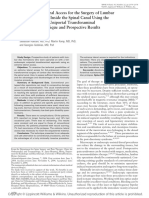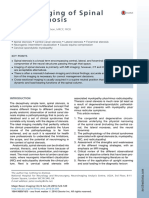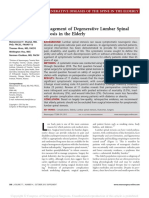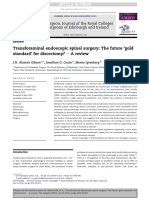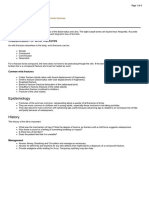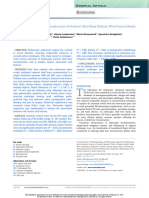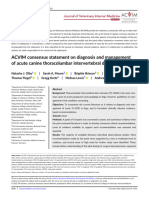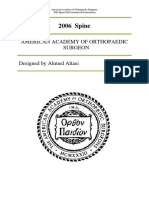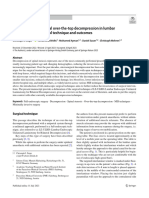Wagner 2020
Wagner 2020
Uploaded by
anshar92Copyright:
Available Formats
Wagner 2020
Wagner 2020
Uploaded by
anshar92Copyright
Available Formats
Share this document
Did you find this document useful?
Is this content inappropriate?
Copyright:
Available Formats
Wagner 2020
Wagner 2020
Uploaded by
anshar92Copyright:
Available Formats
Endoscopic Spine Surgery Special Section
Indications and Contraindications of Full-Endoscopic Interlaminar Lumbar
Decompression
Ralf Wagner1 and Monika Haefner2
- BACKGROUND: Spinal stenosis is a common disease performed by surgeons with advanced skills. Endoscopy
with an increasing incidence. Narrowing of the spinal could become the gold standard for treatment of canal
canal is caused by bone and soft tissue degeneration, such stenosis in the near future.
as osteophyte formation, facet and ligamentum flavum hy-
pertrophy, and disc herniation. Various surgical techniques
have been used to treat spinal canal stenosis, including
open, tubular, microsurgical decompression, and fusion
surgery. This article presents the technique for full- INTRODUCTION
endoscopic interlaminar bilateral decompression of the
lumbar spine.
- METHODS: Surgical approach, anatomy, pathology, in-
dications, contraindications, and surgical equipment are
L umbar spinal stenosis is a common disease with an
increasing incidence. Narrowing of the spinal canal leads
to neurogenic claudication as the main symptom. Mainly
middle-aged and older adults have lumbar leg and back pain with
a negative impact on activity level and quality of life requiring
described.
spinal surgery.1 According to a meta-analysis by Jensen et al.,2 the
- RESULTS: With well-chosen endoscopic equipment, sur- mean prevalence estimates for lumbar spinal stenosis based on
gical time can be reduced with minimal collateral damage. clinical diagnoses vary between 11% and 39%. Tomkins-Lane
Clear advantages of full-endoscopic decompression over et al.1 reported that the prevalence of lumbar spinal stenosis is
estimated to be 9% in the general population and up to 47% in
open or other minimally invasive surgery methods are
people >60 years of age.
demonstrated in many clinical studies. The endoscopic
Spinal stenosis is divided into 3 different entities, central spinal
technique has been shown to be effective in spinal canal canal stenosis, lateral recess stenosis, and foraminal stenosis,
decompression with good to excellent clinical results. The according to the anatomic location of the compression. The onset
interlaminar endoscopic approach minimizes iatrogenic of pain associated with spinal stenosis includes mechanical/
injury to the stabilizing anatomic structures while achieving biomechanical, neural, vascular, and inflammatory causes. Hy-
full unilateral and bilateral decompression. A significant pertrophy of the articular process and yellow ligament and disc
improvement in pain and functional outcome scores with herniation are the main reasons for worsening of the clinical
low complication rates has been demonstrated. symptoms of lumbar stenosis. The extent of stenosis observed in
imaging procedures does not have to correlate with the clinical
- CONCLUSIONS: This technique is safe for lumbar spinal symptoms.3-5
decompression and more minimally invasive than a micro- Various surgical techniques have been used for the treatment of
endoscopic approach. However, this technique should be spinal canal stenosis, including tubular and microsurgical
Key words PELD: Percutaneous endoscopic lumbar discectomy
- Contralateral
- Disc herniation From the 1Ligamenta Spine Center, Frankfurt; and 2Endoscopic Spine Experts, Joimax GmbH,
- Full-endoscopic Karlsruhe, Germany
- Interlaminar
To whom correspondence should be addressed: Ralf Wagner, Dr. Med.
- Ipsilateral
[E-mail: w_ralf@hotmail.com]
- Lateral recess
Citation: World Neurosurg. (2020).
- Ligamentum flavum
https://doi.org/10.1016/j.wneu.2020.08.042
- Lumbar decompression
- Spinal stenosis Journal homepage: www.journals.elsevier.com/world-neurosurgery
Available online: www.sciencedirect.com
Abbreviations and Acronyms
1878-8750/$ - see front matter ª 2020 Elsevier Inc. All rights reserved.
LDH: Lumbar disc herniation
WORLD NEUROSURGERY -: ---, - 2020 www.journals.elsevier.com/world-neurosurgery 1
ENDOSCOPIC SPINE SURGERY SPECIAL SECTION
RALF WAGNER AND MONIKA HAEFNER FULL-ENDOSCOPIC LUMBAR DECOMPRESSION
decompression and fusion surgery.6 With the development of often very small. A stenotic interlaminar window may lead to an
endoscopic techniques for decompression of the lumbar spine, increased difficulty of reaching and removing pathology with an
alternative treatment options with less tissue trauma, lower interlaminar approach. Manipulation in a narrow space could
costs, and similar or better results have been developed, injure the nerve root and the cauda equina. In this case, sufficient
especially for older patients.7-9 A targeted and bone removal at the medial facet joint increases the available
pathology-oriented approach is the key to success to ensure the working space and reduces the risk of neural injury.
therapeutic effect.10 The most important full-endoscopic tech- Two types of disc herniations have to be differentiated: the
niques are the transforaminal and interlaminar approaches.8,11,12 shoulder and the axillary type. The exact position of a disc
Transforaminal endoscopic techniques have been reported to be sequester has to be identified first. In younger patients, a split of
successful in disc surgery and unilateral foraminal stenosis, but the ligamentum flavum may be sufficient to advance to the her-
there are anatomic limitations for symptomatic bilateral recess niated disc. In the case of an additional stenosis, laminoplasty and
stenosis. These limitations, especially at the level of L5-S1, are a restoration of the anatomy are often necessary. The approach to an
high iliac crest, a large L5 transverse process, a large facet joint, axillary herniated disc starts in the median at the cranial lamina
and a narrowed disc space.13 rim of the caudal vertebra. In the case of a shoulder type hernia-
The interlaminar endoscopic technique is similar to tubular tion, the approach starts slightly paramedian at the craniolateral
decompression surgery, meaning the anatomic orientation is border of the interlaminar window.
familiar and similar in both techniques.14 Full-endoscopic inter- With the ipsilateral approach, the angle between the working
laminar decompression shows that all the procedures of open tube/endoscope and pathology is perpendicular, which can be a
decompression can be completely substituted by endoscopic limiting factor. The contralateral approach (over-the-top) leads
management.15 With advances in endoscopic spinal surgery directly to the pathology and is possible for caudal or cranial
methods and instruments, earlier contraindications have become migrated disc herniations.
indications for full-endoscopic spinal decompression in the Unilateral recess stenosis can be treated by unilateral decom-
treatment of lumbar degenerative diseases. Advantages are pression either from the ipsilateral or from the contralateral side.
reduced destruction of the structures and preservation of stability To effectively decompress the lateral recess, it is necessary to
while achieving full unilateral and bilateral decompression.16 restore the normal anatomy. To achieve the original spatial con-
ditions, a high-speed drill is used to remove the osteophytes.
MATERIALS AND METHODS Decompression of the ipsilateral recess is usually achieved by a
medial facetectomy. In cases of severe unilateral recess stenosis,
Indications the contralateral approach is a safe procedure to decompress the
Interlaminar techniques are indicated for disc herniation, lateral contralateral recess, nerve root, or foraminal area. For patients
recess stenosis, central canal stenosis, ligamentum flavum hy- with bilateral neurological symptoms, a unilateral laminotomy
pertrophy, facet joint cysts and hypertrophy, foraminal pathol- with a bilateral decompression can be recommended. This over-
ogies, and adhesions. the-top technique allows 2-sided decompression via a 1-sided
endoscopic surgical access, which further reduces the approach
Full-Endoscopic Interlaminar Approach Technique trauma. The contralateral approach has 2 main advantages. The
Anesthesia and Patient Positioning. The procedure is performed oblique working direction allows a better preparation of stenotic
with the patient in prone position. The available anesthesia op- tissue and less facet joint resection is required. Facet joint cysts or
tions are local or general anesthesia. A possible scheme for severe adhesions often require extensive dissection and, in the
conscious sedation is a combination of midazolam, remifentanil, author’s experience, seem to benefit from a more oblique
and oxygen via nasal cannula. The drugs are dosed individually by contralateral approach (Figure 2AeC).
titration and also based on the different stages of intervention.
The author prefers general anesthesia without (long-lasting) Surgical Equipment. The right choice of instruments, especially the
muscle relaxants. With both anesthesia options, the straight leg endoscope, can save a lot of time and prevent complications. The
sign can be tested during the surgery. The author prefers general diameter of the endoscope defines its mobility inside the spinal
anesthesia. canal (Figure 3A and B). The small-diameter endoscope (up to
6.3 mm outer diameter) is used for herniated disc surgery and has
Surgical Approach and Technical Aspects. In some cases, several the advantage of intracanal mobility. The resection of compressive
approaches are feasible. The access route finally chosen should be disc material is possible with a ligamentum flavum split only,
efficient, safe, and least time-consuming. The initial approach especially in young patients. The small-diameter endoscope is
steps are determination of needle access and target point and more delicate and less useful in lateral recess or central stenosis.
needle placement (Figure 1A and B). After soft tissue dilation, the The medium-diameter endoscope (up to 7.3 mm outer diameter) is
working tube is placed, and the endoscope is advanced. Under the choice for unilateral recess stenosis as well as combined anterior
endoscopic visualization, the interlaminar space is identified. and posterior pathologies. This endoscope allows a lateral recess
Further advancement to the spinal canal can be achieved either decompression as well as discectomy. A high-speed diamond drill is
by splitting or by complete resection of the ligamentum flavum. used to resect the caudal portion of the cranial lamina. Then the
The following aspects have to be considered for a successful yellow ligament is identified and resected using Kerrison punches
outcome: anatomy, pathology, and approach. At the level of L5-S1, (Figure 2C). The rotation of the endoscope helps with direct
the interlaminar window is largest, whereas the neuroforamen is visualization of the thecal sac and the lateral margin of the
2 www.SCIENCEDIRECT.com WORLD NEUROSURGERY, https://doi.org/10.1016/j.wneu.2020.08.042
ENDOSCOPIC SPINE SURGERY SPECIAL SECTION
RALF WAGNER AND MONIKA HAEFNER FULL-ENDOSCOPIC LUMBAR DECOMPRESSION
Figure 1. Landmarks interlaminar access (A). Access angle and entry point determined by pathology (B).
traversing nerve root. Once the traversing nerve is visualized, it is decompression, the contralateral side is prepared after ipsilateral
mobilized using the blunt dissector. The annulus and end plates decompression. The endoscope and the working cannula are then
anterior to the traversing nerve root are visualized. Direct directed toward the contralateral side, dorsal to the dural sac. While
visualization of the traversing nerve root should be obtained from performing the contralateral laminotomy, it is better to keep the
the tip of the superior articulating facet to the midpedicular line of ligamentum flavum intact to protect the dural sac.
the caudal pedicle and may be verified using fluoroscopy. The The undercutting technique above the intact ligamentum fla-
superior articular process is identified. Then the bone drill is used vum should be performed until the medial aspect of the contra-
to resect along the lateral margin of the traversing nerve root to lateral facet can be reached. The remaining ligamentum flavum is
undercut the medial aspect of the facet joint until the lateral then completely removed using endoscopic punches and other
margin of the traversing nerve root is decompressed. This instruments starting from the midline to the lateral recess. The
endoscope can also be used for contralateral decompression of the surgical field is under permanent visual control and constantly
neuroforamen and lateral recess. In most cases of neuroforaminal irrigated with saline solution.
compression, the transforaminal approach has more promising
results with shorter surgery time. Contraindications
The large-diameter endoscope (up to 10 mm outer diameter) Pathologies such as calcified discs, severe stenosis, cauda equina
allows a very effective decompression of the spinal canal. The initial syndrome, painless weakness, or severe fibrotic tissue adhesions can
decompression can be achieved with a cranial and caudal lam- be contraindications for full-endoscopic interlaminar discectomy,
inotomy using a big-sized Endo-Kerrison (joimax GmbH, Karls- depending on the surgeon’s level of training. Pyogenic spondylo-
ruhe, Germany) and a medial facetectomy. In the case of bilateral discitis and other severe spine infections are contraindicated.
Figure 2. Ipsilateral and contralateral approach (A). foramen (B). Diamond abrasor (C). Endo Kerrison punch:
Removal of osteophytes at upper pedicle of contralateral opening of the ligamentum flavum and the bony lamina (D).
WORLD NEUROSURGERY -: ---, - 2020 www.journals.elsevier.com/world-neurosurgery 3
ENDOSCOPIC SPINE SURGERY SPECIAL SECTION
RALF WAGNER AND MONIKA HAEFNER FULL-ENDOSCOPIC LUMBAR DECOMPRESSION
Figure 3. Design of endoscopes (A). Different diameter channel; OD, outer diameter; OS, optical system;
endoscopes inside spinal canal (B). IC, irrigation WChD, working channel diameter.
DISCUSSION which is a possible option for this procedure as described above. This
Systematic reviews and meta-analyses prove the therapeutic effects study reported successful and satisfactory outcomes for patients. Kim
of full-endoscopic lumbar discectomy to be superior or at least et al.24 also used a medium-sized endoscope for contralateral
equivalent compared with standard open lumbar micro- decompression of the neuroforamen and lateral recess.
discectomy. Measured clinical outcome parameters are success Liu et al.21 concluded in their study comparing the outcomes of
rate, complication rate, recovery time, visual analog scale, MacNab patients with highly migrated LDH treated with percutaneous
criteria, operative time, and patient satisfaction.17-20 The surgical endoscopic lumbar discectomy (PELD) by the 3 approaches that the
approach depends on the location and the type of pathology. The interlaminar approach had the least operative time and radiograph
access method finally chosen should be the most efficient, the frequency. Less trauma is proven by many studies and authors. The
safest, and the least time-consuming.14,21,22 study by Kim et al.13 showed that endoscopic discectomy is a
In a study by Liu et al.,21 the contralateral transforaminal, minimally invasive procedure that reduces damage to the muscular
interlaminar, and transforaminal approaches for highly migrated and ligamentous structures, thus allowing for faster rehabilitation,
lumbar disc herniation (LDH) were compared. The interlaminar shorter hospital stay, and earlier return to work by preserving the
approach proved to be the approach with the shortest operating bone and facet structures. In this study recurrence seemed the
time and the highest success rate (92.6%). Markovic et al.22 most prominent complication associated with percutaneous
reported similar results in 350 patients with LDH using an endoscopic interlaminar lumbar discectomy. However, the result of
interlaminar unilateral approach. The full-endoscopic interlam- the study showed that the higher recurrence is due to the age of
inar technique is reliable, sufficient, and safe when taking the the patient and not due to the surgical method.
appropriate indications into account. A medium-sized endoscope To obtain satisfactory clinical efficacy, adequate consideration
allowed the removal of all disc material. Rotation of the endo- should be given to the indication for PELD.27 Good indications for
scope helps with direct visualization of the nerve root and to less experienced surgeons are herniated discs at levels L4-5 and
undercut the facet joint. The superior articular process is resected L5-S1. On these levels the laminar windows are particularly large,
along the lateral margin of the traversing nerve root.23,24 and no or only minor laminar structures have to be removed.
Kim et al.24,25 looked at lumbar stenoses in 2 studies. Unilateral Lumbar central stenosis with unilateral radiculopathy resulting
recess stenosis is mostly treated by unilateral decompression from from hypertrophied ligamentum with or without a small contained
either the ipsilateral or the contralateral side.24 The contralateral disc herniation are also good cases to start with. Proper selection
approach has the advantage of an oblique way of preparation and of the patients is the most important predictor for better prognosis
allows better preparation of stenotic tissue with the advantage of and is essential for successful surgical results.22,23
less facet joint resection.25 For patients with bilateral neurological Some clinical findings, such as anatomic anomalies, spinal
symptoms, a unilateral laminotomy can be recommended. In this deformities, and spondylolisthesis, can make surgery considerably
study by Kim et al.,25 a 10-mm outer diameter endoscope was more difficult. Severe spondylotic changes, such as facet hyper-
used for the uniportal-contralateral full-endoscopic interlaminar trophy or scoliosis, and a congenital narrow spinal canal require
approach for bilateral lumbar decompression of spinal stenosis. For precise planning of the approach. These cases should be treated
this pathology, the use of a large-diameter endoscope is also rec- by experienced surgeons only. A higher degree of disc degenera-
ommended by the author. Komp et al.26 demonstrated good tion with potential instability may require additional stabilization
clinical results with that technique. procedures. Comorbidities also need to be taken into account in
Huang et al.15 used an endoscope (working channel 4.3 mm) for regard to the anesthesia protocol. Full-endoscopic spine surgery
full-endoscopic uniportal unilateral laminotomy for bilateral offers enormous advantages in the treatment of patients with
decompression. This corresponds to a medium-diameter endoscope, multiple comorbidities.
4 www.SCIENCEDIRECT.com WORLD NEUROSURGERY, https://doi.org/10.1016/j.wneu.2020.08.042
ENDOSCOPIC SPINE SURGERY SPECIAL SECTION
RALF WAGNER AND MONIKA HAEFNER FULL-ENDOSCOPIC LUMBAR DECOMPRESSION
Kim et al.25 stated that minimally invasive surgery techniques and orientation. Therefore, it might be helpful to use an assistant
may result in lower complication rates and lower use of hospital to stabilize the endoscope and working tube in the beginning.
resources in patients at greater risk for complications. Endoscopic Additional help from a holding arm or assistant might be
decompression for lumbar stenosis can be considered an required. A holding arm restricts the movement of the endoscope
important alternative treatment in elderly and comorbid patients. but limits the accessibility of certain pathologies.
It can also be performed under epidural anesthesia. Considering The surgeon has to overcome a certain learning curve before
risk factors and complications related to surgical procedures endoscopic treatment leads to clinical success without complica-
themselves, open surgery is likely to cause more complications.25 tions. Markovic et al.22 pointed out that surgeons must pay
Disc herniation at the L5-S1 level can be adequately treated endo- attention to avoid complications during the learning curve. The
scopically with an interlaminar approach. Chen et al.28 found that plateau of the learning curve and good short-term clinical re-
general anesthesia and local anesthesia are both effective with sults of full-endoscopic interlaminar and transforaminal surgery
local anesthesia being better. In a retrospective study, Chen may be achieved after 20 operations, given extensive previous
et al.29 described PELD as emergency surgery for acute cauda experience in microsurgery. Risk of complications at the learning
equina syndrome caused by LDH. Their observations showed that phase may be decreased by excluding patients with symptoms
PELD can provide enough decompression of disc prolapse and a lasting >2 years.33 Morgenstern et al.34 found a learning curve of
satisfactory outcome for patients, even as an emergency 72 cases is needed to reach the goal of 90% of good/excellent
procedure for cauda equina syndrome. Although the rate of results for transforaminal endoscopic lumbar discectomy. In the
common perioperative complications, such as epidural author’s experience, the interlaminar approach requires about 20
hematoma, dorsal dural tear, and surgical site infection, can be cases to achieve good/excellent clinical results. Huang et al.15
relatively low,17,30 there may be some unique adverse events, such stated that a steep learning curve restricts the development of
as a ventral dural tear, nerve root injury to exiting nerve root, and endoscopic decompression.
increased radiation exposure.31 PELD has gained increasing recognition for its many advan-
Lee et al.14 compared microscopic, tubular, and endoscopic tages, such as small incision, less muscle trauma, quick recovery,
lumbar stenosis decompression. The rates of complications and short hospital stay, and at least equivalent clinical outcome
revisions were not significantly different among the 3 groups. They compared with open surgery.14,16,30
concluded that minimally invasive surgery decompression is
clinically feasible and safe to treat the lumbar canal and lateral
recess stenosis. It has many surgical advantages compared with CONCLUSIONS
traditional open microscopic technique.14 The meta-analysis of Clear advantages of full-endoscopic decompression over open or
Chen et al.29 showed that PELD had the lowest risk of overall other minimally invasive surgery methods are demonstrated in
complications in 17 evaluated randomized controlled trials many clinical studies. Minimal iatrogenic trauma to muscles and
comparing PELD with open discectomy/microdiscectomy in the stabilizing structures, less blood loss, shorter hospital stay, quick
surgical treatment of symptomatic LDH. Markovic et al.30 recovery, minimal scar tissue, and fewer complications have been
confirmed that the full-endoscopic technique has advantages over demonstrated. Significant improvement in pain and functional
microsurgery. outcome scores with low complication rates have been demon-
The advantage of the interlaminar approach is the familiar strated. Direct visualization helps to prevent nerve root injury and
anatomic orientation similar to tubular techniques. Choi et al.23 to verify a complete decompression. Although treatment of some
stated that in their view for a spine surgeon having experience indications was restricted previously, it is now possible to address
in open spine decompression procedures, the interlaminar all kinds of compression syndromes and lumbar pathologies. The
approach is fairly simple technique owing to familiarity of only limitation is the training level of the surgeon. Therefore, this
approach and anatomy.22,32 The interlaminar technique is technique should be performed by surgeons with advanced skills.
effective for posterior decompression of structures. Central With well-chosen endoscopic equipment, surgical time can be
stenosis can be approached similar to microsurgical technique reduced, and minimal collateral damage can be achieved.
with Kerrison punches, burrs, and a large-diameter endoscope. Endoscopy could become the gold standard for treatment of canal
Anatomy and orientation are easier compared with the trans- stenosis in the near future.23
foraminal approach.
There are some limitations or disadvantages related to endo-
scopic interlaminar spine surgery. The difficulty in interlaminar CRediT AUTHORSHIP CONTRIBUTION STATEMENT
endoscopy is mainly the handling of the instruments, whereas the Ralf Wagner: Methodology, Writing - original draft, Investigation.
obstacle in transforaminal surgery is the anatomic understanding Monika Haefner: Conceptualization, Writing - review & editing.
2. Jensen RK, Jensen TS, Koes B, Hartvigsen J. 3. Rydevik B. Neurophysiology of cauda equina
REFERENCES Prevalence of lumbar spinal stenosis in general compression. Acta Orthop Scand. 1993;64:52-55.
and clinical populations: a systematic review
1. Tomkins-Lane C, Melloh M, Lurie J, et al. ISSLS
and meta-analysis [e-pub ahead of print]. Eur
Prize Winner: Consensus on the clinical diagnosis 4. Takahashi K, Miyazakit T, Takino T, Tomita K.
Spine J https://doi.org/10.1007/s00586-020-06339-1,
of lumbar spinal stenosis. Spine (Phila Pa 1976). Epidural pressure measurement. Relationship
accessed June 29, 2020.
2016;41:1239-1246. between epidural pressure and posture in patients
WORLD NEUROSURGERY -: ---, - 2020 www.journals.elsevier.com/world-neurosurgery 5
ENDOSCOPIC SPINE SURGERY SPECIAL SECTION
RALF WAGNER AND MONIKA HAEFNER FULL-ENDOSCOPIC LUMBAR DECOMPRESSION
with lumbar spinal stenosis. Spine (Phila Pa 1976). and survey of efficacy and safety in 2 years of follow- microsurgical laminotomy technique: a prospec-
1995;20:650-653. up. World Neurosurg. 2020;134:e672-e681. tive, randomized, controlled study. Pain Physician.
2015;18:61-70.
5. Torgerson WR, Dotter WE. Comparative roent- 16. Xin Z, Huang P, Zheng G, et al. Using a percu-
genographic study of the asymptomatic and taneous spinal endoscopy unilateral posterior 27. Pan M, Li Q, Li S, et al. Percutaneous endoscopic
symptomatic lumbar spine. J Bone Joint Surg Am. interlaminar approach to perform bilateral lumbar discectomy: indications and complica-
1972;58:850-853. decompression for patients with lumbar lateral tions. Pain Physician. 2020;23:49-56.
recess stenosis. Asian J Surg. 2020;43:593e602.
6. Demirayak M, Sisman L, Turkmen F, et al. Clin- 28. Chen HT, Tsai CH, Chao SC, et al. Endoscopic
ical and radiological results of microsurgical 17. Chen X, Chamoli U, Lapkin S, et al. Complication discectomy of L5-S1 disc herniation via an inter-
posterior lumbar interbody fusion and decom- rates of different discectomy techniques for laminar approach: prospective controlled study
pression without posterior instrumentation for symptomatic lumbar disc herniation: a systematic under local and general anesthesia. Surg Neurol Int.
lateral recess stenosis. Asian Spine J. 2015;9: review and meta-analysis. Eur Spine J. 2020;29: 2011;2:93.
713-720. 1752-1770.
29. Chen C, Fan P, Huang L, et al. Percutaneous
7. Kapetanakis S, Gkantsinidoudis N, Thomaidis T, 18. Cong L, Zhu Y, Tu G. A meta-analysis of endo- endoscopic lumbar discectomy as an emergent
et al. The role of percutaneous transforaminal scopic discectomy versus open discectomy for surgery for cauda equina syndrome caused by
endoscopic surgery in lateral recess stenosis in symptomatic lumbar disk herniation. Eur Spine J. lumbar disc herniation. Pain Physician. 2020;23:
elderly patients. Asian Spine J. 2019;13:638-647. 2016;25:134-143. E259-E264.
8. Ruetten S, Komp M, Hahn P, et al. Decompres- 19. Li XC, Zhong CF, Deng GB, et al. Full-endoscopic 30. Markovic M, Zivkovic N, Ruetten S, et al. Full-
sion of lumbar lateral spinal stenosis: full- procedures versus traditional discectomy surgery endoscopic interlaminar versus microsurgical op-
endoscopic, interlaminar technique. Oper Orthop for discectomy: a systematic review and meta- erations in lumbar compressive lesions surgery:
Traumatol. 2013;25:31-46. analysis of current global clinical trials. Pain prospective randomized trial of overall 570 pa-
Physician. 2016;19:103-118. tients. J Pain Relief. 2017;6:6.
9. Tacconi L, Giordan E, Baldo S, et al. Percutaneous
endoscopic lumbar discectomy in the elderly: an 20. Ruan W, Feng F, Liu Z, et al. Comparison of 31. Kim HS, Raorane HD, Hung WP, et al. Incidental
effective treatment for prolapsed disc: consider- percutaneous endoscopic lumbar discectomy versus durotomy during endoscopic stenotic lumbar
ation on 75 case. Interdiscip Neurosurg. 2020;20: open lumbar microdiscectomy for lumbar disc her- decompression: incidence, classification, and
100655. niation: a metaanalysis. Int J Surg. 2016;31:86-92. proposed management strategies. World Neurosurg.
2020;139:e13-e22.
10. Li Y, Wang B, Wang S, et al. Full-endoscopic 21. Liu C, Chu L, Yong HC, et al. Percutaneous
decompression for lumbar lateral recess stenosis endoscopic lumbar discectomy for highly 32. Kim CH, Chung CK. Endoscopic interlaminar
via an interlaminar approach versus a trans- migrated lumbar disc herniation. Pain Physician. lumbar discectomy with splitting of the ligament
foraminal approach. World Neurosurg. 2019;128: 2017;20:E75-E84. flavum under visual control. J Spinal Disord Tech.
e632-e638. 2012;25:210-217.
22. Markovic M, Zivkovic N, Spaic M, Gavrilovi A.
11. Yang J, Wu H, Kong Q, et al. Full endoscopic Full-endoscopic interlaminar operations in lum- 33. Zelenkov P, Nazarov VV, Kisaryev S, et al.
transforaminal decompression surgery for symp- bar compressive lesions surgery: prospective study Learning curve and early results of interlaminar
tomatic lumbar spinal stenosis in geriatric pa- of 350 patients—“ENDOS” study. J Neurosurg Sci. and transforaminal full-endoscopic resection of
tients. World Neurosurg. 2019;127:e449-e459. 2020;64:16-24. lumbar disc herniations. Cureus. 2020;12:e7157.
12. Torudom Y, Dilkhuttakarn T. Two portal percu- 23. Choi G, Deshpande K, Asawasaksakul A, Lee SH. 34. Morgenstern R, Morgenstern C, Yeung AT. The
taneous endoscopic bilateral decompression for New era of percutaneous endoscopic lumbar sur- learning curve in foraminal endoscopic dis-
lumbar spinal stenosis: preliminary study. Asian gery: lumbar stenosis decompression—a technical cectomy: experience needed to achieve a 90%
Spine J. 2016;10:335-342. report. J Spine. 2014;3:5. success rate. Int J Spine Surg. 2007;1:100-107.
13. Kim HS, Park JY. Comparative assessment of 24. Kim HS, Patel R, Paudel B, et al. Early outcomes
different percutaneous endoscopic interlaminar of endoscopic contralateral foraminal and lateral
Conflict of interest statement: R. Wagner is a joimax faculty
lumbar discectomy (PEID) techniques. Pain Physi- recess decompression via an interlaminar
cian. 2013;16:359-367. approach in patients with unilateral radiculopathy member. M. Haefner is an employee of joimax GmbH.
from unilateral foraminal stenosis. World Neuro- Received 7 July 2020; accepted 4 August 2020
14. Lee CW, Yoon KJ, Ha SS. Comparative analysis surg. 2017;108:763-773.
Citation: World Neurosurg. (2020).
between three different lumbar decompression
techniques (microscopic, tubular, and endo- 25. Kim HS, Paudel B, Jang JS, et al. Percutaneous full https://doi.org/10.1016/j.wneu.2020.08.042
scopic) in lumbar canal and lateral recess stenosis: endoscopic bilateral lumbar decompression of Journal homepage: www.journals.elsevier.com/world-
preliminary report. Biomed Res Int. 2019;2019: spinal stenosis through uniportal-contralateral neurosurgery
6078469. approach: techniques and preliminary results.
Available online: www.sciencedirect.com
World Neurosurg. 2017;103:201-209.
15. Huang YH, Lien FC, Chao LY, et al. Full endoscopic 1878-8750/$ - see front matter ª 2020 Elsevier Inc. All
uniportal unilateral laminotomy for bilateral 26. Komp M, Hahn P, Oezdemir S, et al. Bilateral rights reserved.
decompression in degenerative lumbar spinal ste- spinal decompression of lumbar central stenosis
nosis: highlight of ligamentum flavum detachment with the full-endoscopic interlaminar versus
6 www.SCIENCEDIRECT.com WORLD NEUROSURGERY, https://doi.org/10.1016/j.wneu.2020.08.042
You might also like
- CPT Coding Examples For Common Spine Procedures: CervicalNo ratings yetCPT Coding Examples For Common Spine Procedures: Cervical5 pages
- Laminectomy With Fusion Versus Young LaminoplastyNo ratings yetLaminectomy With Fusion Versus Young Laminoplasty6 pages
- Surgical Technique - Treatment of Distal Humerus NonunionsssNo ratings yetSurgical Technique - Treatment of Distal Humerus Nonunionsss10 pages
- Sebastian Ruetten, MD, PHD, Martin Komp, MD, PHD, and Georgios Godolias, MD, ProfNo ratings yetSebastian Ruetten, MD, PHD, Martin Komp, MD, PHD, and Georgios Godolias, MD, Prof9 pages
- Ultrasound-Guided Pudendal Nerve Block at The Entrance of The Pudendal (Alcock) Canal Description of Anatomy and Clinical TechniqueNo ratings yetUltrasound-Guided Pudendal Nerve Block at The Entrance of The Pudendal (Alcock) Canal Description of Anatomy and Clinical Technique6 pages
- (10920684 - Neurosurgical Focus) Surgical Management of Trigeminal Schwannomas - Defining The Role For Endoscopic Endonasal ApproachesNo ratings yet(10920684 - Neurosurgical Focus) Surgical Management of Trigeminal Schwannomas - Defining The Role For Endoscopic Endonasal Approaches9 pages
- Surgical Management of Cervical Ossified Posterior Longitudinal LigamentNo ratings yetSurgical Management of Cervical Ossified Posterior Longitudinal Ligament13 pages
- Management of Panfacial Trauma - Sequencing and PitfallsNo ratings yetManagement of Panfacial Trauma - Sequencing and Pitfalls7 pages
- Endoscopic Septoplasty: Indications, Technique, and ResultsNo ratings yetEndoscopic Septoplasty: Indications, Technique, and Results5 pages
- 2024 - A Critical Review of Endoscopic Spine SurgeryNo ratings yet2024 - A Critical Review of Endoscopic Spine Surgery10 pages
- Conferences and Reviews: Cervical SpondylosisNo ratings yetConferences and Reviews: Cervical Spondylosis9 pages
- Anesthesia Regional y Sindrome Compartamental Nov 21No ratings yetAnesthesia Regional y Sindrome Compartamental Nov 215 pages
- Lawrence Et Al 2021 Contralateral Transmaxillary Approach For Resection of Chondrosarcoma of The Petrous Apex A CaseNo ratings yetLawrence Et Al 2021 Contralateral Transmaxillary Approach For Resection of Chondrosarcoma of The Petrous Apex A Case4 pages
- 2007 Topsakal 2008 IONM of lower cranial nerves in skull base surgery technical report and review of 123 monitored casesNo ratings yet2007 Topsakal 2008 IONM of lower cranial nerves in skull base surgery technical report and review of 123 monitored cases23 pages
- OPERATIVA - Surgical Approaches To The Brain StemNo ratings yetOPERATIVA - Surgical Approaches To The Brain Stem10 pages
- Novel Surgical and Radiologic Classification of The Subtympanic Sinus: Implications For Endoscopic Ear SurgeryNo ratings yetNovel Surgical and Radiologic Classification of The Subtympanic Sinus: Implications For Endoscopic Ear Surgery6 pages
- FandAC - 2017 - Hamid - Chronic Rupture of Peroneal TendonsNo ratings yetFandAC - 2017 - Hamid - Chronic Rupture of Peroneal Tendons8 pages
- Combined Transnasal and Transoral Endoscopic Approaches To The Craniovertebral JunctionNo ratings yetCombined Transnasal and Transoral Endoscopic Approaches To The Craniovertebral Junction6 pages
- Idiopathic Mono Ventricular 114-Article Text-182-1!10!20221007No ratings yetIdiopathic Mono Ventricular 114-Article Text-182-1!10!202210075 pages
- Outcomes of Endoscopic Suturectomy With Postoperative Helmet Therapy in Bilateral Coronal CraniosynostosisNo ratings yetOutcomes of Endoscopic Suturectomy With Postoperative Helmet Therapy in Bilateral Coronal Craniosynostosis6 pages
- Management of Degenerative Lumbar Spinal Stenosis in The ElderlyNo ratings yetManagement of Degenerative Lumbar Spinal Stenosis in The Elderly7 pages
- Anatomical Landmarks For Transnasal EndoscopicNo ratings yetAnatomical Landmarks For Transnasal Endoscopic8 pages
- Original Paper: Lumbar Disk Herniations - Clinical Status, Diagnosis, Imaging, Surgical Treatment and Global OutcomeNo ratings yetOriginal Paper: Lumbar Disk Herniations - Clinical Status, Diagnosis, Imaging, Surgical Treatment and Global Outcome6 pages
- hemispherectomy-indications-surgical-techniques-complications-andoutcome-2155-9562-1000300No ratings yethemispherectomy-indications-surgical-techniques-complications-andoutcome-2155-9562-10003005 pages
- Distal Humerus Fractures: Roongsak Limthongthang, MD, and Jesse B. Jupiter, MDNo ratings yetDistal Humerus Fractures: Roongsak Limthongthang, MD, and Jesse B. Jupiter, MD10 pages
- Solitary Plasmacytoma of The Thoracolumbar Spine A Rare Cas - 2022 - InterdisciNo ratings yetSolitary Plasmacytoma of The Thoracolumbar Spine A Rare Cas - 2022 - Interdisci5 pages
- 2012 Transient Common Peroneal Nerve Palsy Following Skeletal Tibial Traction in A Morbidly Obese Patient - Case Report of A Preventable ComplicationNo ratings yet2012 Transient Common Peroneal Nerve Palsy Following Skeletal Tibial Traction in A Morbidly Obese Patient - Case Report of A Preventable Complication5 pages
- Gibson Et Al-2012-Transforaminal Endoscopic Spinal SurgeryNo ratings yetGibson Et Al-2012-Transforaminal Endoscopic Spinal Surgery7 pages
- Assesment of Functional Outcome of Dual Plating For Comminuted Distal Femur FractureNo ratings yetAssesment of Functional Outcome of Dual Plating For Comminuted Distal Femur Fracture13 pages
- Single-Stage Endoscopic Endonasal Approach For The Complete Removal of Trigeminal Schwannomas Occupying Both The Middle and Posterior FossaeNo ratings yetSingle-Stage Endoscopic Endonasal Approach For The Complete Removal of Trigeminal Schwannomas Occupying Both The Middle and Posterior Fossae10 pages
- Endoscopic Endonasal Reconstruction of Anterior Skull Base Defects What Factors Really Affect The OutcomesNo ratings yetEndoscopic Endonasal Reconstruction of Anterior Skull Base Defects What Factors Really Affect The Outcomes8 pages
- Diagnosis and Treatment of Neurogenic Oropharyngeal DysphagiaFrom EverandDiagnosis and Treatment of Neurogenic Oropharyngeal DysphagiaNo ratings yet
- ACVIM Consensus Statement On Diagnosis and Managment of Acute Canine Thoracolumbar Intervertebral Disc ExtrusionNo ratings yetACVIM Consensus Statement On Diagnosis and Managment of Acute Canine Thoracolumbar Intervertebral Disc Extrusion27 pages
- Veterinary Neurologic Rehabilitation The Rationale For ANo ratings yetVeterinary Neurologic Rehabilitation The Rationale For A9 pages
- (PDF Download) Advanced Techniques in Canine and Feline Neurosurgery Andy Shores Fulll Chapter100% (6)(PDF Download) Advanced Techniques in Canine and Feline Neurosurgery Andy Shores Fulll Chapter64 pages
- Institute of Orthopedics Sports Medicine: Daily CensusNo ratings yetInstitute of Orthopedics Sports Medicine: Daily Census4 pages
- A Case Study Oftraumatic Spinal Cord Injury100% (1)A Case Study Oftraumatic Spinal Cord Injury111 pages
- 6002 Spine: American Academy of Orthopaedic SurgeonNo ratings yet6002 Spine: American Academy of Orthopaedic Surgeon52 pages
- Title Prevalence of Kinesiophobia and Discontentment in Post Laminectomy Patients and Its Impact On Physical Activities A Cross-Sectional StudyNo ratings yetTitle Prevalence of Kinesiophobia and Discontentment in Post Laminectomy Patients and Its Impact On Physical Activities A Cross-Sectional Study35 pages
- Endoscopic-Assisted Microsurgical Techniques at The CraniovertebralNo ratings yetEndoscopic-Assisted Microsurgical Techniques at The Craniovertebral9 pages
- CANINE-Lateral and Foraminal Disk Extrusion in DogsNo ratings yetCANINE-Lateral and Foraminal Disk Extrusion in Dogs7 pages
- Case Report: Severe Facet Joint Arthrosis Caused C7/T1 Myelopathy: A Case ReportNo ratings yetCase Report: Severe Facet Joint Arthrosis Caused C7/T1 Myelopathy: A Case Report7 pages
- Full Endoscopic Bilateral Over The Top Decompression in LumbarNo ratings yetFull Endoscopic Bilateral Over The Top Decompression in Lumbar6 pages
- Pre-Revised and Revised Procedure Charges From Jan 1, 2016No ratings yetPre-Revised and Revised Procedure Charges From Jan 1, 201626 pages
- Lumbar Spinal Stenosis: An Update On The Epidemiology, Diagnosis and TreatmentNo ratings yetLumbar Spinal Stenosis: An Update On The Epidemiology, Diagnosis and Treatment15 pages
- CPT Coding Examples For Common Spine Procedures: CervicalCPT Coding Examples For Common Spine Procedures: Cervical
- Surgical Technique - Treatment of Distal Humerus NonunionsssSurgical Technique - Treatment of Distal Humerus Nonunionsss
- Sebastian Ruetten, MD, PHD, Martin Komp, MD, PHD, and Georgios Godolias, MD, ProfSebastian Ruetten, MD, PHD, Martin Komp, MD, PHD, and Georgios Godolias, MD, Prof
- Ultrasound-Guided Pudendal Nerve Block at The Entrance of The Pudendal (Alcock) Canal Description of Anatomy and Clinical TechniqueUltrasound-Guided Pudendal Nerve Block at The Entrance of The Pudendal (Alcock) Canal Description of Anatomy and Clinical Technique
- (10920684 - Neurosurgical Focus) Surgical Management of Trigeminal Schwannomas - Defining The Role For Endoscopic Endonasal Approaches(10920684 - Neurosurgical Focus) Surgical Management of Trigeminal Schwannomas - Defining The Role For Endoscopic Endonasal Approaches
- Surgical Management of Cervical Ossified Posterior Longitudinal LigamentSurgical Management of Cervical Ossified Posterior Longitudinal Ligament
- Management of Panfacial Trauma - Sequencing and PitfallsManagement of Panfacial Trauma - Sequencing and Pitfalls
- Endoscopic Septoplasty: Indications, Technique, and ResultsEndoscopic Septoplasty: Indications, Technique, and Results
- 2024 - A Critical Review of Endoscopic Spine Surgery2024 - A Critical Review of Endoscopic Spine Surgery
- Anesthesia Regional y Sindrome Compartamental Nov 21Anesthesia Regional y Sindrome Compartamental Nov 21
- Lawrence Et Al 2021 Contralateral Transmaxillary Approach For Resection of Chondrosarcoma of The Petrous Apex A CaseLawrence Et Al 2021 Contralateral Transmaxillary Approach For Resection of Chondrosarcoma of The Petrous Apex A Case
- 2007 Topsakal 2008 IONM of lower cranial nerves in skull base surgery technical report and review of 123 monitored cases2007 Topsakal 2008 IONM of lower cranial nerves in skull base surgery technical report and review of 123 monitored cases
- Novel Surgical and Radiologic Classification of The Subtympanic Sinus: Implications For Endoscopic Ear SurgeryNovel Surgical and Radiologic Classification of The Subtympanic Sinus: Implications For Endoscopic Ear Surgery
- FandAC - 2017 - Hamid - Chronic Rupture of Peroneal TendonsFandAC - 2017 - Hamid - Chronic Rupture of Peroneal Tendons
- Combined Transnasal and Transoral Endoscopic Approaches To The Craniovertebral JunctionCombined Transnasal and Transoral Endoscopic Approaches To The Craniovertebral Junction
- Idiopathic Mono Ventricular 114-Article Text-182-1!10!20221007Idiopathic Mono Ventricular 114-Article Text-182-1!10!20221007
- Outcomes of Endoscopic Suturectomy With Postoperative Helmet Therapy in Bilateral Coronal CraniosynostosisOutcomes of Endoscopic Suturectomy With Postoperative Helmet Therapy in Bilateral Coronal Craniosynostosis
- Management of Degenerative Lumbar Spinal Stenosis in The ElderlyManagement of Degenerative Lumbar Spinal Stenosis in The Elderly
- Original Paper: Lumbar Disk Herniations - Clinical Status, Diagnosis, Imaging, Surgical Treatment and Global OutcomeOriginal Paper: Lumbar Disk Herniations - Clinical Status, Diagnosis, Imaging, Surgical Treatment and Global Outcome
- hemispherectomy-indications-surgical-techniques-complications-andoutcome-2155-9562-1000300hemispherectomy-indications-surgical-techniques-complications-andoutcome-2155-9562-1000300
- Distal Humerus Fractures: Roongsak Limthongthang, MD, and Jesse B. Jupiter, MDDistal Humerus Fractures: Roongsak Limthongthang, MD, and Jesse B. Jupiter, MD
- Solitary Plasmacytoma of The Thoracolumbar Spine A Rare Cas - 2022 - InterdisciSolitary Plasmacytoma of The Thoracolumbar Spine A Rare Cas - 2022 - Interdisci
- 2012 Transient Common Peroneal Nerve Palsy Following Skeletal Tibial Traction in A Morbidly Obese Patient - Case Report of A Preventable Complication2012 Transient Common Peroneal Nerve Palsy Following Skeletal Tibial Traction in A Morbidly Obese Patient - Case Report of A Preventable Complication
- Gibson Et Al-2012-Transforaminal Endoscopic Spinal SurgeryGibson Et Al-2012-Transforaminal Endoscopic Spinal Surgery
- Assesment of Functional Outcome of Dual Plating For Comminuted Distal Femur FractureAssesment of Functional Outcome of Dual Plating For Comminuted Distal Femur Fracture
- Single-Stage Endoscopic Endonasal Approach For The Complete Removal of Trigeminal Schwannomas Occupying Both The Middle and Posterior FossaeSingle-Stage Endoscopic Endonasal Approach For The Complete Removal of Trigeminal Schwannomas Occupying Both The Middle and Posterior Fossae
- Endoscopic Endonasal Reconstruction of Anterior Skull Base Defects What Factors Really Affect The OutcomesEndoscopic Endonasal Reconstruction of Anterior Skull Base Defects What Factors Really Affect The Outcomes
- Diagnosis and Treatment of Neurogenic Oropharyngeal DysphagiaFrom EverandDiagnosis and Treatment of Neurogenic Oropharyngeal Dysphagia
- ACVIM Consensus Statement On Diagnosis and Managment of Acute Canine Thoracolumbar Intervertebral Disc ExtrusionACVIM Consensus Statement On Diagnosis and Managment of Acute Canine Thoracolumbar Intervertebral Disc Extrusion
- Veterinary Neurologic Rehabilitation The Rationale For AVeterinary Neurologic Rehabilitation The Rationale For A
- (PDF Download) Advanced Techniques in Canine and Feline Neurosurgery Andy Shores Fulll Chapter(PDF Download) Advanced Techniques in Canine and Feline Neurosurgery Andy Shores Fulll Chapter
- Institute of Orthopedics Sports Medicine: Daily CensusInstitute of Orthopedics Sports Medicine: Daily Census
- 6002 Spine: American Academy of Orthopaedic Surgeon6002 Spine: American Academy of Orthopaedic Surgeon
- Title Prevalence of Kinesiophobia and Discontentment in Post Laminectomy Patients and Its Impact On Physical Activities A Cross-Sectional StudyTitle Prevalence of Kinesiophobia and Discontentment in Post Laminectomy Patients and Its Impact On Physical Activities A Cross-Sectional Study
- Endoscopic-Assisted Microsurgical Techniques at The CraniovertebralEndoscopic-Assisted Microsurgical Techniques at The Craniovertebral
- CANINE-Lateral and Foraminal Disk Extrusion in DogsCANINE-Lateral and Foraminal Disk Extrusion in Dogs
- Case Report: Severe Facet Joint Arthrosis Caused C7/T1 Myelopathy: A Case ReportCase Report: Severe Facet Joint Arthrosis Caused C7/T1 Myelopathy: A Case Report
- Full Endoscopic Bilateral Over The Top Decompression in LumbarFull Endoscopic Bilateral Over The Top Decompression in Lumbar
- Pre-Revised and Revised Procedure Charges From Jan 1, 2016Pre-Revised and Revised Procedure Charges From Jan 1, 2016
- Lumbar Spinal Stenosis: An Update On The Epidemiology, Diagnosis and TreatmentLumbar Spinal Stenosis: An Update On The Epidemiology, Diagnosis and Treatment





